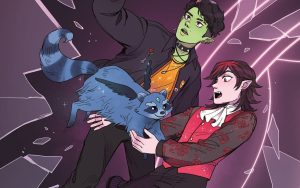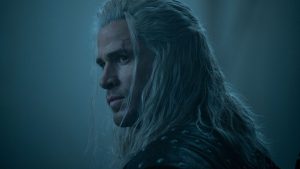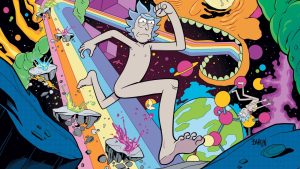When Ahsoka premiered on Disney+, the series essentially acted as an immediate sequel to Star Wars Rebels, focusing on the return of Grand Admiral Thrawn and the search for Ezra Bridger—a continuation of that animated saga’s most pressing cliffhangers and unanswered questions. The anticipation for Thrawn’s live-action debut, and the promise of a villain with the intelligence and support capable of truly uniting the fragmented Imperial remnants, was massive. Yet, as the season unfolded, a far more ancient, cosmic, and potentially galaxy-altering plot thread began to unfold—one that manages to cast a shadow over someone who looms as large and dangerous as Thrawn: the Mortis Gods.
The live action reveal of a statue of the Mortis Gods on Peridea, discovered by the former Jedi Baylan Skoll, suggests that the true game being played on Peridea—the planet in a completely separate galaxy where both Thrawn and Ezra had been stranded for years—is not merely about a political power struggle coming to the known galaxy, but a desperate quest for a power beyond brute force that sits at the very foundation of the Force itself. This storyline that is set up to be explored in Season 2 of Ahsoka, which delves into the deep lore of something bigger than anything else seen in Star Wars to date, hints at an ambition that could fundamentally reshape our understanding of the established canon, moving beyond the familiar cycles of light and dark, Empire and Rebellion, and into the realm of myth and legend.
Baylan Skoll’s true motivation was the season’s greatest surprise, shifting the story away from a mercenary mission to a cosmic odyssey. His quest to get to Peridea was not due to strategic reasons or to rescue Thrawn, but to seemingly learn more about the Mortis Gods—the Father, the Son, and the Daughter. While the Mortis Gods are introduced in live-action in Ahsoka as colossal statues on Peredia, the characters were first introduced in Star Wars: The Clone Wars, and are revealed to be embodiments of the living Force. The Son represents the dark side, the Daughter represents the light side, and the Father is the balance between the two. They existed in a realm outside of time and space when Anakin, Obi-Wan, and Ahsoka found themselves stranded on their world, maintaining the metaphysical balance of the galaxy.
In Ahsoka, Baylan claims that he is searching for “the beginning for power…or the ability to break the cycle.” With the reveal of Baylan standing on the outstretched hand of the Father statue at the end of the season, it implies that his goal is not to find a superweapon or a powerful ally, but to access a source of power so foundational that it can transcend the struggle that has defined the Jedi and Sith for millennia. The Mortis Gods are the Star Wars pantheon, and seeking them out is not a political maneuver—it is a theological one.
The physical evidence on Peridea deepens the mystery and elevates the stakes. The enormous statues are weathered and broken, but the most intriguing detail is the headless statue of the Daughter. In The Clone Wars, the Daughter sacrificed herself to save Ahsoka Tano, symbolically passing a piece of the light side into the Jedi, thus making Ahsoka herself the living embodiment of the light side. Since then, Ahsoka was frequently accompanied by Morai, the Daughter’s mystical green owl-like bird, further signifying the symbolic “passing of the torch” from the Daughter to Ahsoka.
The absence of the Daughter’s head in Ahsoka is a tantalizing puzzle. Is this mere damage from time in a world in a galaxy we as viewers know nothing about, or does it signify an imbalance that has spread across galaxies? The potential implications are staggering, especially with Ahsoka now stranded on Peredia with Baylan. If Baylan is attempting to tap into the very power of the Mortis Gods, he is looking to rewrite the rules of existence. Thrawn’s goal is merely to conquer a galaxy; Baylan’s is to master the Force itself (perhaps as the Father) and stop the endless cycle of conflict.
Baylan’s pursuit of the Mortis Gods opens the door to an entity whose name was never spoken in The Clone Wars but whose presence is central to the wider Mortis mythology: the Mother, also known as Abeloth: the Bringer of Chaos. In the Extended Universe (Legends continuity), the Mother was originally a mortal who attempted to join the Mortis family and, through a corrupted act of seeking immortality to remain with them for eternity, became the monstrous embodiment of pure, unbound chaos and imbalance. She is the complete opposite of the harmony the Father strove to maintain, leading him to trap Abeloth on their original planet (Mortis) and relocate his family to the realm seen in The Clone Wars. While Abeloth’s existence is currently non-canon, the story threads planted in Ahsoka make her introduction into the new canon feel not only possible but perhaps inevitable.
The headless Daughter statue, an entity of pure light, and Baylan’s desperate search for an ultimate power to end the cycle of endless fighting between Sith and Jedi could be a cryptic foreshadowing of this ultimate cosmic horror. If the Mortis Gods—all of whom died in The Clone Wars—can impart at least part of their power/spirit in mortals like Ahsoka, then the entity they worked tirelessly to imprison—the embodiment of chaos—must also be a looming threat that could very well take human form.
The search for the power Baylan is focused on may not be as simple as controlling the balance between the light and dark side, but harnessing the raw energy of Abeloth to destroy the Force itself. Her reintroduction into Star Wars canon would instantly turn the saga’s lore from one of political and military might (Empire vs. New Republic) into a primal, apocalyptic struggle against a metaphysical being of unimaginable power.
This potential storyline regarding the Mortis Gods and Abeloth would re-contextualize the entire Star Wars universe, placing the conflict of the Skywalker saga into a far grander, more ancient, and more terrifying context. The stakes would move from the survival of the New Republic to the literal survival of reality and the Force itself. By planting the seeds for the Mortis Gods and potentially the Mother, Ahsoka has set the stage for a story that is not just bigger than Thrawn, but bigger than the Galactic Civil War, promising to change everything we thought we knew about the very nature of the Force.
The post Star Wars’ Next Live-Action TV Show Has a Story Way Bigger Than Thrawn (It Could Change Everything) appeared first on ComicBook.com.




